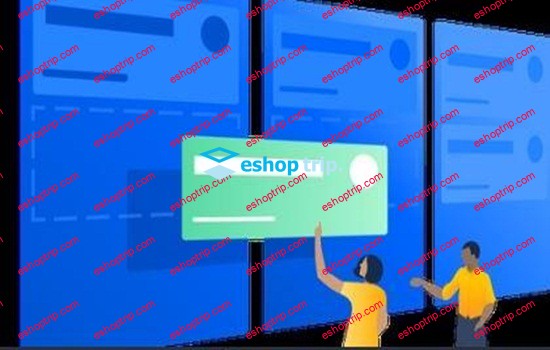Published 7/2024
Created by Nivasa S
MP4 | Video: h264, 1280×720 | Audio: AAC, 44.1 KHz, 2 Ch
Genre: eLearning | Language: English | Duration: 9 Lectures ( 6h 34m ) | Size: 2.88 GB
SAP GRC Access Control ,SAP IAG,SAP Process control,Risk Management ,GRC300,GRC100,GRC330,GRC340,GRC350,GRC360,SECIAG
What you’ll learn:
By the end of a GRC course, students should be equipped with the knowledge and skills to design, implement, and manage GRC programs within organizations, ensuri
By the end of the course, students will have a thorough understanding of GRC 12.0 installation and configuration processes, enabling them to effectively impleme
By the end of the course, students will have a comprehensive understanding of the GRC 12.0 architecture, enabling them to design, implement, and manage an integ
By the end of a GRC course that includes HANA DB installation, students will have gained comprehensive knowledge and practical skills in installing and configur
By the end of the course, students will have a solid foundation in the history and evolution of GRC, as well as a comprehensive overview of its core concepts an
Requirements:
To enroll in an SAP GRC course, students should ideally meet certain prerequisites and have a foundational understanding in related areas to maximize their learning experience. Here are the common requirements and prerequisites: ### Technical Prerequisites 1. **Basic SAP Knowledge**: – Familiarity with SAP ERP system navigation and basic functionalities. – Understanding of SAP system architecture and components. 2. **ABAP Knowledge** (optional but beneficial): – Basic understanding of ABAP programming can be helpful, especially for customization and technical configuration tasks. 3. **Database Knowledge**: – Basic understanding of database concepts, particularly SAP HANA if the course includes HANA DB installation. ### Professional Background 1. **Work Experience**: – Experience in SAP environments, particularly in roles related to IT, auditing, risk management, compliance, or security. – Exposure to governance, risk, or compliance processes within an organization. 2. **Relevant Roles**: – Professionals working as SAP Basis administrators, security administrators, auditors, compliance officers, or IT managers. ### Educational Background 1. **Degree**: – A bachelor’s degree in Information Technology, Computer Science, Business Administration, Finance, or a related field is often beneficial. ### Specific Skills and Knowledge 1. **Governance, Risk, and Compliance Fundamentals**: – Basic understanding of GRC concepts and the importance of these practices in an organization. – Familiarity with key regulations and standards such as SOX, GDPR, and ISO standards. 2. **IT and Security Concepts**: – Understanding of IT security principles and practices. – Knowledge of internal controls and audit processes. ### Soft Skills 1. **Analytical Skills**: – Ability to analyze and interpret data, identify risks, and propose solutions. 2. **Communication Skills**: – Effective communication skills for collaborating with stakeholders and reporting findings. 3. **Problem-Solving Skills**: – Strong problem-solving skills to address and resolve issues related to GRC implementation and management. ### Recommended Courses 1. **SAP Introduction Courses**: – Courses such as SAP01 (SAP Overview) and TERP10 (Integration of Business Processes in SAP ERP) are recommended for those new to SAP. 2. **Security and Authorizations Courses**: – Courses like ADM940 (Authorization Concept for SAP S/4HANA and SAP Business Suite) can provide a solid foundation in SAP security. ### Additional Recommendations 1. **Hands-On Practice**: – Practical experience with SAP systems through internships, labs, or sandbox environments to reinforce learning. 2. **Stay Updated**: – Keeping abreast of the latest developments in GRC practices and SAP technologies through online resources, forums, and professional networks. Meeting these prerequisites will help ensure that students are well-prepared for the SAP GRC course, enabling them to grasp the concepts more effectively and apply them in real-world scenarios.
Description:
Governance, Risk, and Compliance (GRC) is a comprehensive framework for managing an organization’s overall governance, enterprise risk management, and compliance with regulations. Access control is a critical component of GRC, ensuring that only authorized users can access specific information and resources within an organization. Here’s an overview of GRC access control:1. GovernanceDefinition: Governance involves the policies, processes, and structures that ensure the effective and efficient management of an organization.Role in Access Control: Governance establishes the policies and frameworks that define how access control should be implemented and managed. It ensures that access control mechanisms align with the organization’s objectives and regulatory requirements.2. Risk ManagementDefinition: Risk management is the process of identifying, assessing, and mitigating risks that could potentially affect the organization’s ability to achieve its goals.Role in Access Control: Risk management involves identifying risks related to unauthorized access and implementing controls to mitigate those risks. This includes assessing the impact and likelihood of access-related threats and vulnerabilities.3. ComplianceDefinition: Compliance refers to adhering to laws, regulations, guidelines, and specifications relevant to the organization.Role in Access Control: Compliance ensures that access control mechanisms meet legal and regulatory requirements. This includes adherence to standards such as GDPR, HIPAA, SOX, and others that mandate specific access control measures.4. Access Control MechanismsAuthentication: Verifying the identity of users before granting access.Methods: Passwords, biometrics, multi-factor authentication (MFA), etc.Authorization: Granting or denying permissions to users based on their identity and roles.Role-Based Access Control (RBAC): Access rights are assigned based on user roles within the organization.Attribute-Based Access Control (ABAC): Access rights are granted based on attributes (e.g., department, clearance level).Discretionary Access Control (DAC): Owners of resources specify who can access their resources.Mandatory Access Control (MAC): Access rights are regulated by a central authority based on multiple levels of security.5. Policies and ProceduresAccess Control Policies: Define how access rights are granted, reviewed, and revoked.Examples: Least privilege principle, segregation of duties, periodic access reviews.Access Control Procedures: Detailed steps and processes for implementing access control policies.Examples: User provisioning, access request workflows, incident response procedures.6. Technology and ToolsIdentity and Access Management (IAM) Systems: Solutions that provide tools and technologies to manage digital identities and enforce access control policies.Single Sign-On (SSO): Allows users to authenticate once and gain access to multiple systems without re-entering credentials.Access Control Lists (ACLs): Lists that specify which users or system processes are granted access to objects and what operations are allowed.7. Monitoring and AuditingContinuous Monitoring: Ongoing oversight of access control activities to detect and respond to unauthorized access attempts.Auditing: Regular reviews and audits of access control logs and configurations to ensure compliance and identify areas for improvement.8. Challenges and Best PracticesChallenges: Balancing security with user convenience, managing access across diverse systems, ensuring compliance with dynamic regulations, mitigating insider threats.Best Practices: Regularly updating access control policies, conducting periodic access reviews, using least privilege principles, employing multi-factor authentication, and training employees on access control policies and procedures.By integrating robust access control mechanisms within the GRC framework, organizations can effectively manage who has access to their critical resources, reduce the risk of unauthorized access, and ensure compliance with relevant regulations.
Who this course is for:
The SAP GRC course is designed for a variety of professionals who are involved in governance, risk management, compliance, and related areas within an organization. The course is suitable for: ### Target Audience 1. **IT Professionals**: – **SAP Basis Administrators**: Responsible for the installation, configuration, and maintenance of SAP systems. – **SAP Security Administrators**: Focused on managing user access, roles, and authorizations within SAP environments. – **System Administrators**: Overseeing the overall health and performance of IT systems, including SAP landscapes. 2. **Risk Management Professionals**: – **Risk Managers**: Identifying, assessing, and mitigating risks within the organization. – **Internal Auditors**: Conducting audits to ensure compliance with internal policies and external regulations. 3. **Compliance Officers**: – Ensuring that the organization adheres to legal and regulatory requirements. – Implementing and monitoring compliance programs and controls. 4. **Finance and Accounting Professionals**: – **Accountants**: Ensuring accurate financial reporting and compliance with financial regulations. – **Financial Controllers**: Overseeing the organization’s financial operations and internal controls. 5. **Business Process Owners**: – Individuals responsible for managing and optimizing business processes within the organization. – Ensuring that business processes are compliant with regulatory requirements and internal policies. 6. **IT Auditors**: – Conducting IT audits to evaluate the effectiveness of controls and ensure compliance with regulations and standards. – Identifying vulnerabilities and recommending improvements to enhance security and compliance. 7. **Project Managers**: – Managing projects related to the implementation and optimization of GRC solutions. – Ensuring that projects are delivered on time, within scope, and in compliance with regulatory requirements. 8. **Consultants**: – SAP consultants specializing in GRC who provide advisory services to organizations. – Assisting clients in implementing and optimizing GRC solutions. 9. **Security Professionals**: – **Information Security Managers**: Ensuring the protection of information assets and compliance with security regulations. – **Cybersecurity Analysts**: Identifying and mitigating cybersecurity risks and ensuring compliance with security policies. ### Ideal Candidate Traits 1. **Analytical Skills**: – Strong analytical skills to understand and interpret data, identify risks, and develop mitigation strategies. 2. **Attention to Detail**: – High attention to detail to ensure accuracy in compliance reporting and risk assessment. 3. **Problem-Solving Skills**: – Ability to identify issues and develop effective solutions to address them. 4. **Communication Skills**: – Effective communication skills to interact with various stakeholders, present findings, and provide recommendations. 5. **Technical Proficiency**: – Proficiency in SAP systems and understanding of technical aspects related to SAP GRC implementation. ### Benefits for Participants 1. **Career Advancement**: – Gaining specialized knowledge in SAP GRC can open up new career opportunities and advancement prospects. 2. **Enhanced Skill Set**: – Developing a comprehensive understanding of GRC processes, tools, and best practices. 3. **Organizational Impact**: – Ability to contribute to the organization’s governance, risk management, and compliance efforts. 4. **Industry Recognition**: – Earning certifications and gaining expertise in SAP GRC can enhance professional credibility and recognition within the industry. Overall, the SAP GRC course is for professionals who play a crucial role in ensuring that their organization adheres to governance, risk management, and compliance requirements, and who seek to enhance their skills and knowledge in these areas.
Homepage










